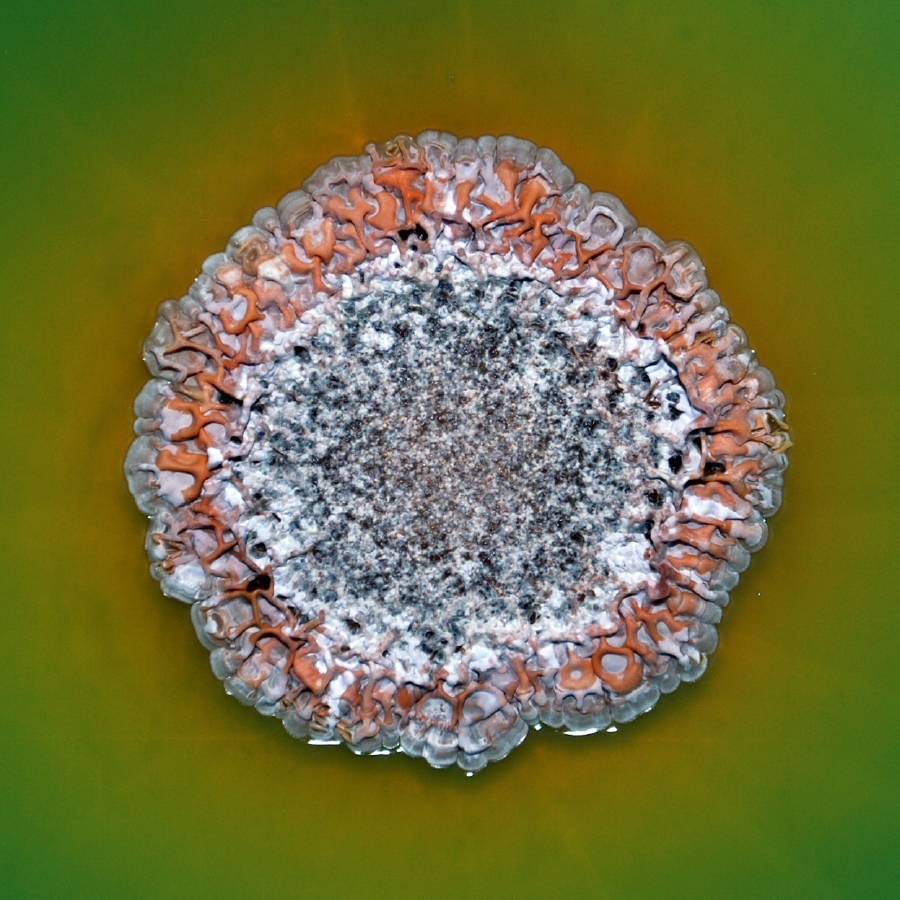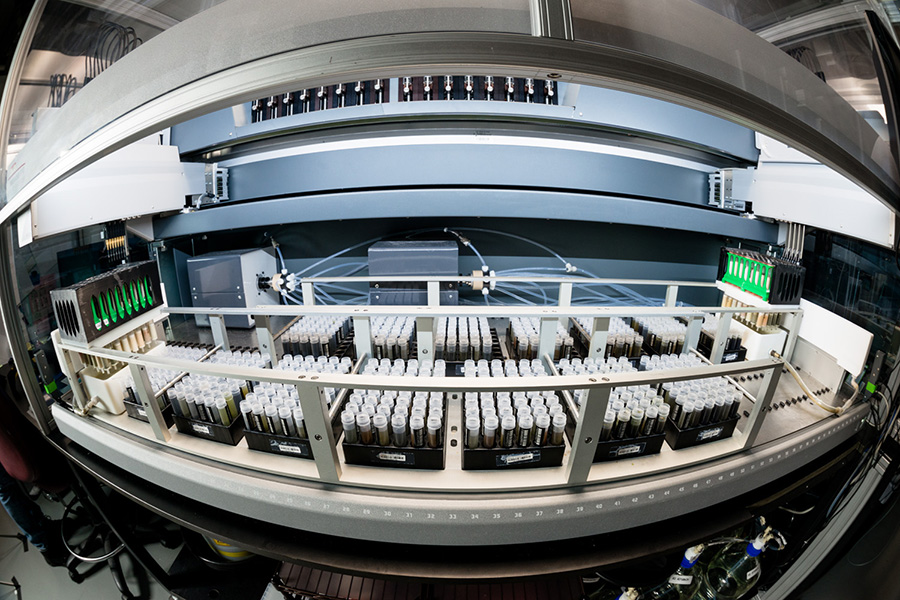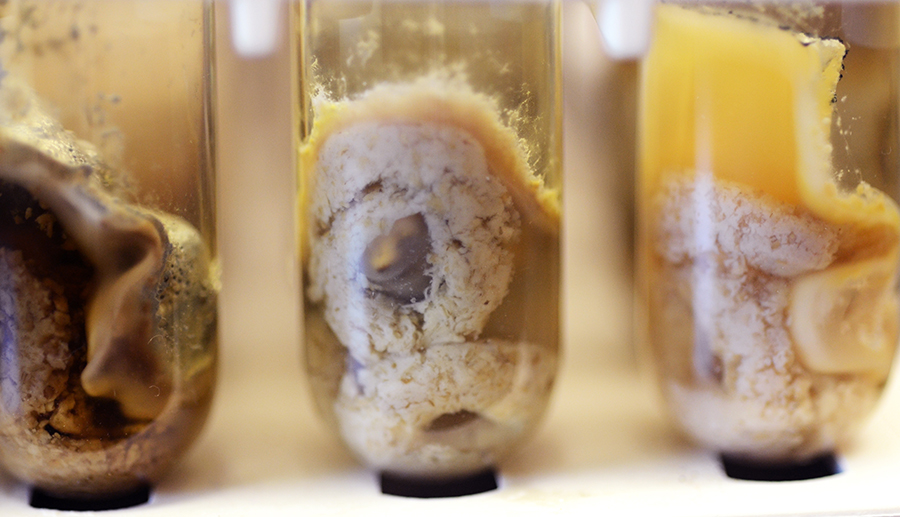
Nature’s Bounty: Revitalizing the Discovery of New Cancer Drugs from Natural Products
March 22, 2019, by NCI Staff
Most people wouldn’t expect to find a meat grinder in a research laboratory. But, according to Tanja Grkovic, Ph.D., it’s the perfect tool for grinding up frozen marine organisms.
“It really does the job!” she said.
Dr. Grkovic*, a Croatian-born chemist, should know: she has spent the last several years intimately involved in improving processes for analyzing products of nature—from marine creatures to soil-dwelling fungi to plant leaves—to see whether chemical compounds within them might be starting blocks for new cancer drugs.
The work has been part of an ambitious, Cancer MoonshotSM-funded initiative, called the NCI Program for Natural Products Discovery (NPNPD), to make it easier for other researchers to mine nature for leads on new cancer drugs.
A big part of that story has taken place in the well-worn home of NCI’s Natural Products Branch, on the NCI campus in Frederick, MD.
On a tour of the building, Dr. Grkovic showed off freezer rooms filled with samples of natural products collected from across the globe, all the while explaining the highly complex process of converting those samples from their original states to a few grams of material in bar-coded test tubes.
Natural products have been a bedrock of drug discovery for many decades, she said. It’s estimated that more than half of all cancer drugs and antibiotics originated from a chemical compound discovered in a natural product.
Paclitaxel (Taxol), for example, one of the most commonly used chemotherapy drugs, was derived from the bark of the Pacific yew tree; penicillin, one of the first antibiotics, from a mold; and drugs to lower cholesterol from compounds found in fungi.
However, Barry O’Keefe, Ph.D., who heads the Natural Products Branch, explained that, despite this impressive track record, natural products have fallen out of favor as a source for new drug discovery. That’s largely because of the extensive time and effort needed to go from a bit of algae or sliver of tree bark to a compound that can be tested for its ability to kill cancer cells.
“Most people just don’t want to work with natural products anymore; it’s too challenging,” Dr. O’Keefe said. Instead, many researchers and pharmaceutical companies now rely primarily on large “libraries” of man-made, chemically synthesized compounds for cancer drug discovery.
But given the great potential and unmatched chemical diversity found in nature, in 2015, NCI leadership decided that the institute should launch an effort to encourage the research community to rediscover natural products. The NPNPD was established not long after.
“We knew it would be a big undertaking,” Dr. O’Keefe said. “But if we did it, we thought, it could change everything.”
A National Treasure
Beginning in the mid-1980s, the Natural Products Branch—housed on the grounds of NCI’s campus at Fort Detrick, an active military base in Frederick—collected more than 100,000 samples of plants and marine organisms from 25 tropical and subtropical countries across the globe, from the forests of Madagascar to the coastal waters of Thailand.
“The idea was to capture a great diversity of species,” Dr. Grkovic said.
The samples were collected via contractual arrangements, typically with organizations that study and preserve the natural world, such as international and state botanical gardens and marine science institutes.
Those collections were all performed under legal agreements that ensured that any given country’s natural resources would not be depleted or damaged in any way. The agreements also stipulated that, should the products lead to any marketable discoveries—namely, a new drug—the country from which the original product came would share in any profits.
But what makes natural products such a promising avenue of drug discovery in the first place?
One particularly enticing feature of natural products is their ability to produce molecules that can have a biological effect on other organisms, said Susan Mooberry, Ph.D., a professor of pharmacology at UT Health San Antonio, who specializes in drug discovery using natural products.
Take self-defense, for example.
“Plants can’t move. Sponges can’t move. So they have to develop mechanisms to protect themselves,” Dr. Mooberry said. Marine organisms known as tunicates (also called sea squirts), for instance, which spend much of their life anchored to rocks and docks, produce an arsenal of toxins to ward off predators.
Such chemical compounds are “information rich,” said Daniel Romo, Ph.D., of Baylor University, who specializes in chemically synthesizing potential drug leads derived from natural products. For example, Dr. Romo continued, “they can interact with cellular proteins in new and interesting ways, and that’s often what can lead to the development of new drug targets and drugs.”
But even as NCI and other organizations and companies have continued to make samples of natural products available to the research community—in the form of minimally processed materials known as crude extracts—their use in drug discovery has declined dramatically.
The chief reason? Unlike crude extracts from natural products, libraries of human-created synthesized compounds are tailor-made for high-throughput screening: highly automated systems for rapidly testing the effects of chemical compounds on biological material.
To be suitable for high-throughput screening, on the other hand, natural product extracts must undergo a process known as fractionation, whereby they are transformed into a more purified state that allows for the compounds within them to be more easily isolated.
Think of individual crude extracts as a forest full of trees, said Dr. Grkovic.
“The fractions from those extracts are like single trees in that forest,” she continued. “A pure compound [in a fraction] is like a single leaf from one of the trees.”
The fractionation process also helps to weed out what are often called “nuisance compounds” and other molecules that can make the results from high-throughput screening unreliable, Dr. Mooberry said.
Few labs have the ability or resources to fractionate crude extracts, she noted. So over time, researchers and drug companies instead turned to the more economical libraries of human-synthesized compounds.
Recognizing this trend, shortly after Dr. O’Keefe became chief of NCI’s natural products program in 2015, he proposed a way to reinvigorate the use of nature’s bounty for drug discovery: do the up-front work for researchers by prefractionating NCI’s treasure trove of natural product crude extracts. Those fractions would then be made available to anybody with a viable research plan to mine them for potentially promising compounds.
“Now the research community is going to have access to more chemical diversity than has ever been available in history,” he said. “And it’s free.”
From Months and Months to Weeks
A short walk from the original Natural Products Branch labs, the new NPNPD facility is the antithesis of the old labs: high ceilings, bright lights, loads of stainless steel, and a host of high-tech machines and devices (robots abound) for transforming crude extracts into fractions and preparing those fractions for high-throughput screening.
The lab’s centerpiece is a massive vault-like storage room that will eventually house more than 1 million bar-coded test tubes containing fractions from more than 140,000 crude extracts in NCI’s collection.
Within the temperature-controlled vault is a large robotic arm that can travel the 40-foot length and 15-foot height of the room, quickly pulling tubes from thousands of custom-designed racks stacked in shelves from floor to ceiling.
The facility is the proving ground for the processes NPNPD staff have developed and refined for fractionating natural product crude extracts, Dr. O’Keefe said. That work has reduced what used to be a months-long, largely manual process to something that is now highly automated and can be completed in a few weeks.
“We worked through methods for dealing with each type of source material—marine, plant, microbial—how best to go about purification of this material, and how best to automate that process,” he said.
That effort extended to the process for preparing fractions in the test tubes to be sent out for screening. In a matter of days, the samples in those tubes can undergo additional processing (more robots), eventually winding up on tiny plates with hundreds of dimples, or wells—each with a few milliliters of different fractions—and then delivered to a requesting lab, ready for testing.
In late January, NPNPD fulfilled the first order for prefractionated samples from its library.
“We’ve had interest from large academic labs and researchers from around the world,” Dr. O’Keefe said.
More Than Just a Supply House
As efficient as NPNPD’s prefractionation process is, the fractions still have some complexity about them. Based on testing done at NPNPD, Dr. Grkovic explained, on average, the prefractionated samples contain approximately 20 active chemical compounds.
So if a high-throughput screen does show that a fraction being tested kills, say, breast cancer or leukemia cells, it can take a few more rounds of testing to isolate the compound responsible for the cell-killing activity.
The NPNPD has the capacity and expertise to conduct those additional analyses, Dr. O’Keefe said, and can work with researchers to perform them.
Using technologies like liquid chromatography–mass spectrometry and nuclear magnetic resonance spectroscopy, NPNPD scientists can take an active compound identified by a screening lab and, in a matter of weeks, determine its precise chemical structure. That information is important if a researcher wants to understand how the compound kills cancer cells or wants to modify, or optimize, the compound for further studies and drug development.
“So, because we have the capacity and we have the throughput, we now have information on [a compound’s] chemical structure only two steps removed from a crude extract,” Dr. Grkovic said.
Backyard Citizen Science
An area of focus moving forward for the NPNPD is hunting for cancer-killing compounds produced by microbes and fungi found in soil.
That decision was borne out of a social media post that went viral. In March 2015, a user on the popular social media site Reddit posted about the University of Oklahoma’s Citizen Science Soil Collection Program and its goal of using a “scoop of dirt” from backyards across the country to discover new drugs. The post caught fire, and in the ensuing weeks and months the program was flooded with backyard soil samples from across the United States.
Faced with more samples than he knew what to do with, the program’s leader, Robert H. Cichewicz, Ph.D., connected with Dr. O’Keefe to see if NCI was interested in taking advantage of this abundance of dirt. Fast forward a few years, and one part of the new NPNPD laboratory is dedicated to prefractionation of crude extracts from soil microbes.
Dr. Mooberry’s work is an example of soil’s potential to generate leads for cancer drugs. Several years ago, her lab tested a compound from a fungus in a soil sample submitted to the Oklahoma program from a person in Alaska. It showed an impressive ability to kill one type of triple-negative breast cancer cells.
Although that particular compound is not moving forward into further studies, more recently her lab showed that a different compound isolated from a soil-derived fungi from the Oklahoma program could specifically kill Ewing sarcoma cells. A rare and hard-to-treat cancer, Ewing sarcoma is most commonly diagnosed in children and young adults.
Results from the studies have yet to be published, Dr. Mooberry noted, but she’s hopeful that the compound may help researchers identify a vulnerability in Ewing sarcoma cells against which new targeted therapies can be developed.
A New Opportunity
The timing of the NPNPD’s launch is good, Dr. Romo said. Libraries of synthesized compounds have not been as successful at producing new drugs as many had hoped, he noted. And synthetic chemists have become much more adept at creating new, highly complex chemical compounds based on promising leads generated from natural products.
“We’re getting better at making more and more complex molecules,” he said.
Of course, there’s no certainty that any compound, even one that shows great promise in lab studies, will prove to be effective at treating cancer in humans, Dr. Mooberry stressed. But the history of success with drugs derived from natural products cannot be discounted, she continued.
And now, with the NPNPD, she said, “we have a new opportunity to make a difference if more people start screening these fractions.”
The younger generation of researchers may take up that challenge, Dr. O’Keefe said. Over the past year, he has given presentations on the NPNPD around the country. Almost uniformly, he continued, the most excited response has come from young investigators.
As he explained: “Young researchers keep coming up to me, saying ‘Thank you so much because nobody was going to give me funding to go out into the field to do collections or to conduct extractions. Now that I have this resource, I can just start my research.’”
* Dr. Grkovic is a senior scientist in the Natural Products Support Group, which is part of the Frederick National Laboratory for Cancer Research, an NCI-sponsored contractor-operated facility.

























.png)










No hay comentarios:
Publicar un comentario